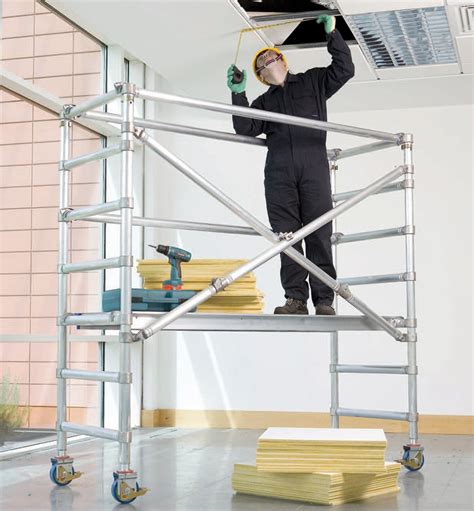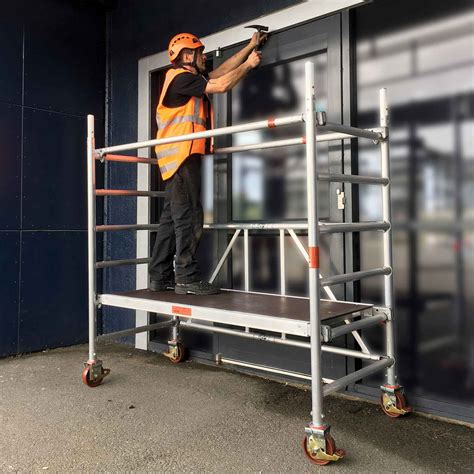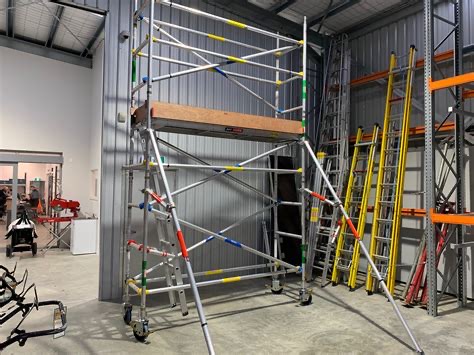Content Menu
● Understanding Mobile Tower Scaffolds and Their Surface Requirements
● Why a Mobile Tower Scaffold Must Not Be Used on Unsafe Surfaces
● What Surfaces Should a Mobile Tower Scaffold Not Be Used On?
>> 1. Uneven or Sloping Surfaces
>> 2. Soft or Unstable Ground
>> 3. Rough or Unfinished Surfaces
>> 4. Slippery Surfaces
>> 5. Surfaces Near Overhead Hazards
>> 6. Surfaces with Insufficient Load-Bearing Capacity
● Key Safety Guidelines: When a Mobile Tower Scaffold Must Not Be Used
● Additional Safety Measures for Using Mobile Tower Scaffolds
● Common Mistakes to Avoid
● The Role of Ground Protection in Mobile Tower Scaffold Safety
● Weather Conditions and Surface Safety
● Legal and Regulatory Considerations
● Summary: Surfaces Where a Mobile Tower Scaffold Must Not Be Used
● Conclusion
● FAQ
>> 1. Why must a mobile tower scaffold not be used on uneven surfaces?
>> 2. Can a mobile tower scaffold be used on soft ground?
>> 3. Is it safe to move a mobile tower scaffold with workers on the platform?
>> 4. What precautions should be taken near overhead power lines?
>> 5. How can I ensure a mobile tower scaffold is stable on a sloping surface?
Mobile tower scaffolds are invaluable tools for working safely at height, offering flexibility, mobility, and a stable platform. However, their safe use depends heavily on the surface on which they are erected and moved. A mobile tower scaffold must not be used on unstable, uneven, or hazardous surfaces, as this can lead to serious accidents including falls, scaffold collapse, or tipping over. This comprehensive article discusses in detail the types of surfaces where a mobile tower scaffold must not be used, the reasons why, safety precautions, and best practices for safe scaffold operation.

Understanding Mobile Tower Scaffolds and Their Surface Requirements
A mobile tower scaffold is a freestanding, wheeled scaffold system designed to be easily moved around a worksite. Its mobility and height make it ideal for tasks such as painting, maintenance, and construction where access to elevated areas is required.
However, the design of mobile tower scaffolds inherently requires a firm, level, and stable surface to ensure safety. A mobile tower scaffold must not be used on surfaces that compromise its stability or increase the risk of tipping or collapse.
Why a Mobile Tower Scaffold Must Not Be Used on Unsafe Surfaces
Using a mobile tower scaffold on inappropriate surfaces can lead to:
- Instability and Collapse: Uneven or soft ground can cause the scaffold legs or wheels to sink or shift, destabilizing the structure.
- Overturning: Slopes or inclined surfaces increase the risk of the scaffold tipping over, especially when extended to height.
- Damage to Equipment: Rough or unfinished surfaces can damage casters and locking mechanisms, affecting safe mobility.
- Increased Risk of Falls and Injuries: An unstable platform endangers workers on the scaffold and those below.
What Surfaces Should a Mobile Tower Scaffold Not Be Used On?
1. Uneven or Sloping Surfaces
A mobile tower scaffold must not be used on uneven or sloping surfaces without proper leveling and stabilization. The scaffold's base must be level in all directions to prevent tipping. Even small inclines can cause instability, especially at greater heights.
2. Soft or Unstable Ground
Surfaces such as loose soil, mud, sand, gravel, or grass are not suitable for mobile tower scaffolds. These soft surfaces can cause scaffold legs or wheels to sink or shift unexpectedly.
3. Rough or Unfinished Surfaces
A mobile tower scaffold must not be used on rough, unfinished, or debris-covered floors. Such surfaces can damage the scaffold's wheels and locking mechanisms, reducing stability and mobility.
4. Slippery Surfaces
Wet, icy, oily, or otherwise slippery surfaces increase the risk of scaffold movement or worker slips. A mobile tower scaffold must not be used on these surfaces unless adequate anti-slip measures are in place.
5. Surfaces Near Overhead Hazards
A mobile tower scaffold must not be used on surfaces where overhead hazards such as power lines, tree branches, or low ceilings exist without proper clearance. Contact with power lines can cause electrocution.
6. Surfaces with Insufficient Load-Bearing Capacity
Floors or platforms that cannot support the scaffold's weight plus workers and materials are unsafe. A mobile tower scaffold must not be used on surfaces where the load capacity is unknown or inadequate.

Key Safety Guidelines: When a Mobile Tower Scaffold Must Not Be Used
- Never use a mobile tower scaffold on an uneven or sloping surface without proper leveling devices. Adjustable legs are for minor leveling only and must not be used to compensate for large slopes or uneven ground.
- A mobile tower scaffold must not be used on soft or unstable ground without adequate base plates, sole boards, or ground protection mats to distribute the load. This prevents sinking and instability.
- Do not move a mobile tower scaffold with workers or materials on the platform. Movement should only occur when the platform is clear to avoid falls or tipping.
- Avoid using a mobile tower scaffold on surfaces near overhead electrical hazards unless proper clearance and precautions are ensured. Maintain at least 10 feet distance from power lines.
- A mobile tower scaffold must not be used on slippery surfaces unless anti-slip measures are implemented. This includes wet, icy, or oily floors.
- Scaffold casters must have fully functioning wheel and swivel locks and must be locked before use. Failure to lock casters on unstable surfaces can cause movement and accidents.
Additional Safety Measures for Using Mobile Tower Scaffolds
- Use Outriggers or Stabilizers: For towers above certain heights (e.g., 2 meters), outriggers must be fitted to increase the base width and stability.
- Conduct Daily Inspections: Check the scaffold structure, casters, locking mechanisms, and surface conditions before use.
- Follow Manufacturer's Instructions: Always assemble and use the scaffold as per the manufacturer's guidelines.
- Training: Only trained and competent personnel should erect, dismantle, or move mobile tower scaffolds.
Common Mistakes to Avoid
- Using adjustable legs to gain extra height instead of leveling.
- Moving the scaffold with occupants on the platform.
- Ignoring uneven or soft ground conditions and failing to use base plates or mats.
- Using scaffolds with red safety tags indicating they are unsafe for use.
- Leaving scaffolds unattended in unsafe conditions or bad weather.
The Role of Ground Protection in Mobile Tower Scaffold Safety
One important consideration often overlooked is the use of ground protection equipment. A mobile tower scaffold must not be used on soft or delicate surfaces without appropriate ground protection such as sole boards, scaffold base plates, or ground mats.
These accessories help distribute the scaffold's weight over a larger area, preventing wheels or legs from sinking into soft ground like mud, grass, or sand. Using ground protection is vital on construction sites with variable ground conditions or indoors on fragile flooring.
Weather Conditions and Surface Safety
A mobile tower scaffold must not be used on surfaces affected by adverse weather conditions without additional precautions. For example:
- Rain: Wet surfaces become slippery, increasing the risk of falls and scaffold movement.
- Ice and Snow: Frozen surfaces are hazardous for scaffold stability and worker footing.
- High Winds: Wind can cause scaffold sway or tipping, especially on uneven or unsecured surfaces.
Always assess weather conditions before erecting or moving a mobile tower scaffold and postpone work if conditions are unsafe.
Legal and Regulatory Considerations
In many countries, workplace safety regulations explicitly state that mobile tower scaffolds must only be used on suitable surfaces. For example, the UK's Health and Safety Executive (HSE) requires that scaffolds be erected on firm, level ground and that all components be inspected regularly.
Failure to comply with these regulations can result in fines, work stoppages, or serious injury claims. Always ensure your scaffold use aligns with local laws and industry best practices.
Summary: Surfaces Where a Mobile Tower Scaffold Must Not Be Used
Surface Type | Reason Mobile Tower Scaffold Must Not Be Used |
Uneven or Sloping Surfaces | Causes instability and tipping risk |
Soft or Unstable Ground | Leads to sinking and shifting of scaffold legs or wheels |
Rough or Unfinished Surfaces | Damages wheels and locking mechanisms, reduces mobility |
Slippery Surfaces | Increases risk of slips and scaffold movement |
Surfaces Near Overhead Hazards | Risk of electrocution or injury from contact with power lines or branches |
Surfaces with Insufficient Load Capacity | Risk of collapse or floor damage |
Conclusion
A mobile tower scaffold must not be used on surfaces that compromise its stability and safety. Uneven, soft, slippery, or hazardous surfaces increase the risk of accidents such as tipping, collapse, and falls. Understanding which surfaces are unsafe and taking proper precautions—including leveling, using base plates, outriggers, and following manufacturer and regulatory guidelines—are essential for safe scaffold operation. Always prioritize safety by inspecting surfaces and equipment thoroughly before use, and ensure all users are properly trained.
By adhering to these guidelines and avoiding the use of mobile tower scaffolds on inappropriate surfaces, you can significantly reduce the risk of accidents and ensure a safer working environment for everyone involved.

FAQ
1. Why must a mobile tower scaffold not be used on uneven surfaces?
A mobile tower scaffold must not be used on uneven surfaces because it can cause instability, increasing the risk of tipping or collapse.
2. Can a mobile tower scaffold be used on soft ground?
No, a mobile tower scaffold must not be used on soft ground unless appropriate ground protection such as sole boards or mats are used to prevent sinking and instability.
3. Is it safe to move a mobile tower scaffold with workers on the platform?
No, a mobile tower scaffold must not be moved when workers or materials are on the platform to avoid falls and scaffold tipping.
4. What precautions should be taken near overhead power lines?
A mobile tower scaffold must not be used near overhead power lines without maintaining a safe clearance of at least 10 feet to prevent electrocution hazards.
5. How can I ensure a mobile tower scaffold is stable on a sloping surface?
A mobile tower scaffold must not be used on a sloping surface unless it is properly leveled using adjustable legs (within limits) and stabilized with outriggers or other supports as per manufacturer instructions.






















